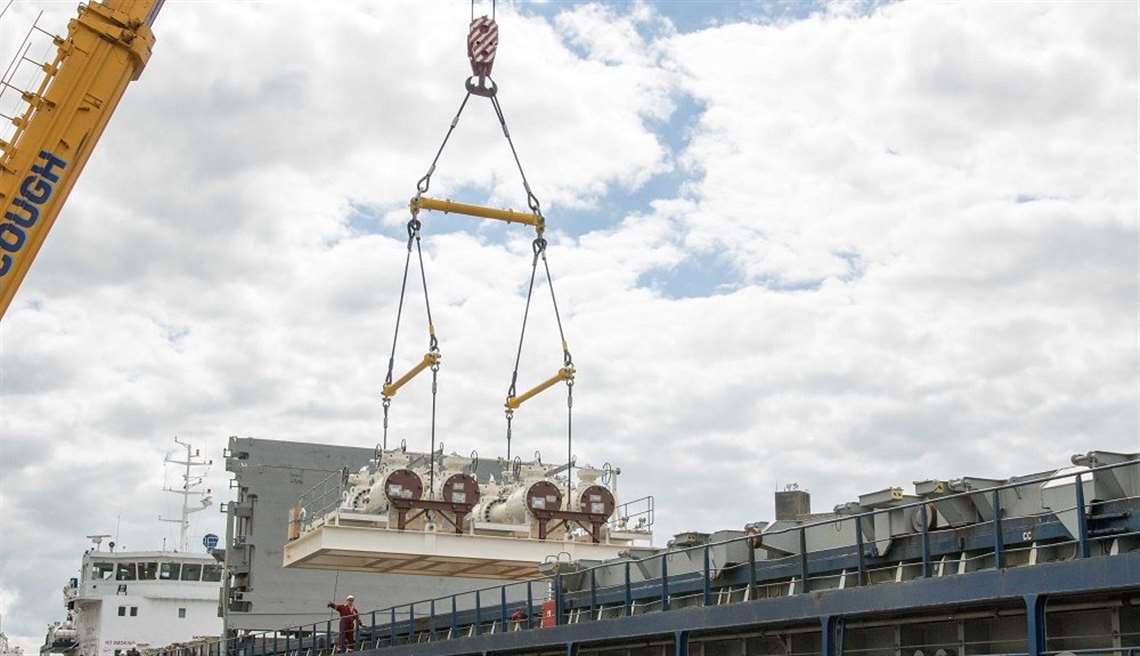Moving Massive Machines
03 November 2017

BY IAN CAMERON
Throughout the global oil & gas and power generation industries one of the frequent challenges is one of the most basic — lifting huge, heavy pieces of equipment, often in hostile environments.
With some items of critical equipment weighing thousands of tonnes, the potential for costly and dangerous failures is obvious.
One company which specializes in providing lifting solutions in various industries including the oil & gas and power generation sectors is Modulift, headquartered in Poole, England.
The company has established a strong reputation working in the offshore sector. Most recently two modified spreader beams from Modulift’s heavy, off-the-shelf range was used to lift two non-identical halves of a helipad onto a vessel from a gas rig in the Dutch sector of the North Sea recently. The site was approximately 70 miles off the Danish coast. The heavier piece of the pad weighed 89 tonnes, while the smaller was 35 tonnes.
Modulift supplies Spreader Beams, Lifting Beams and other below the hook lifting equipment. Modulift Spreader Beams are suitable for most lifting requirements and the range of Spreader Beams offers capacities from 2.0 to 5000 tonnes and spans up to 100 m. Modulift Spreaders have DNV type approval up to 1500 tonnes and their modular configuration and interchangeable components enable them to be reused over many lifts, the company said.
Modulift can also provide advice for all lifting requirements from a custom designed and engineered lifting solution, complex rig design, lifting products or a solution for a super-heavy lift.
Modulift’s project manager Simon Cranny said the company has worked on many contracts throughout the sectors for various companies including Exxon Mobil and Atlas Copco.
These contracts required Modulift’s engineering team to comply with many specified standards and restrictions to design the most suitable lifting solutions. Beams on these projects have had to meet specific quality requirements and undergo stringent testing.
“A project of this nature would typically begin with a formal contract review by the company and depending on complexity and customer requirements, may even require a startup meeting with the client,” Cranny said. “Once all deliverables and actions relating to the project are defined an Inspection and Test Plan (ITP) is drawn up which will include details of all the activities to be carried out in order to fulfill the order in line with the contract specifications.
“On many occasions general arrangement drawings, structural calculations reports, welding procedures, test procedures, paint procedures are submitted to the customer for approval prior to commencement of manufacture and at this juncture any technical or quality related ambiguities are addressed.
“Once all submissions are approved the ITP is amended, as necessary, and a schedule is drawn up as a project plan with key activities and dates specified in order to meet the agreed delivery date.”
The key activities will typically include material procurement and inspection, fabrication of components including weld mapping, non-destructive testing (NDT) of welds (prior to proof testing), proof load testing and post-test NDT (often witnessed by an independent third party) blasting and painting, marking, assembly (if required), packing and final inspection. It is also common for slings and shackles to form part of the order and these are also usually tested with an independent third-party witness.
Sometimes the length of slings required will be determined only after weighing and determination of the load weight and center of gravity of the item and this activity is sometimes carried out by Modulift at the customer’s premises.
The final stage — apart from actual delivery of the physical items — is the compilation and review of the manufacturing record book (MRB) which, in addition to the reports and procedures approved by the customer at the start of the contract, will include material certification, welding records, test reports and certificates, declarations of conformity, calibration certificates and paint reports. Once completed these are sent to the customer in electronic format within one week of delivery of the components.
“One of the main challenges relating to these projects is that the customer will often need to forward the documentation sent to them by Modulift for review and approval by the end user and, although necessary, this can invariably lead to delays,” Cranny said. “Despite this, Modulift will always endeavor to complete the contract by the date that the customer requires the equipment onsite but the above-mentioned delays will present a very real challenge at times in trying to achieve this.
“Another challenge faced on some occasions are the very specific requirements relating to materials, welding and painting which are over and above what is the norm for standard projects.”
POWER SOURCING GUIDE
The trusted reference and buyer’s guide for 83 years
The original “desktop search engine,” guiding nearly 10,000 users in more than 90 countries it is the primary reference for specifications and details on all the components that go into engine systems.
Visit Now
STAY CONNECTED




Receive the information you need when you need it through our world-leading magazines, newsletters and daily briefings.
CONNECT WITH THE TEAM








